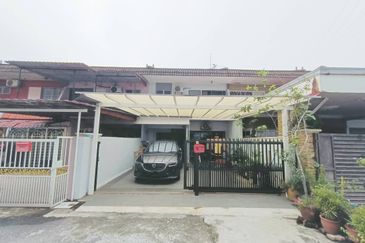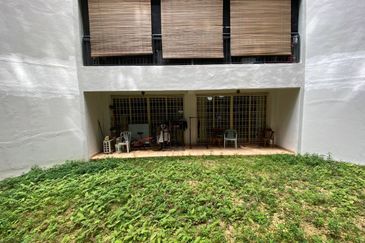

Take TheEdgeProperty.com-Lafarge Happiness in the City Index 2017 survey at http://go.theedgeproperty.com.my/happiness. Ends on May 28.
Being kind to others is the foundation of a warm and caring society. However, how many of us actually care? Would we help an old lady cross the road? Is the road even safe enough for her to walk on? Do we build homes that meet our needs in our golden years? All these are important questions as our future happiness is at stake.
“We constantly hear people say that the city is built for all, not only for the young,” says National Council of Senior Citizens Organisations Malaysia president Datuk Soon Ting Kueh. “But just take a look around Kuala Lumpur — do you think it has been planned, designed or built with the needs of senior citizens in mind?”
 An age-friendly city is one where older people can move around conveniently and smoothly from one place to another, he says.
An age-friendly city is one where older people can move around conveniently and smoothly from one place to another, he says.
“It is more than the exercise facilities provided in the park, or the senior citizen special counter for the aged in the hospital.
“It is about the whole master plan and design of the city,” says the retiree who has been living in the capital city for many years.
“In other words, an age-friendly city should have an enabling environment for the elderly.”
In his eyes, Asian countries in general do not consider the old in its town or city planning. He believes this has something to do with the assumption that the elderly seldom choose to retire in the city but in the suburbs or in more quiet and laid-back places.
“It may be true of the previous generation, but for more modern retirees, many live in the city throughout their lives. They have already made the city their home. Mindsets have changed,” he says. Besides, new retirees are also more independent and active.
“Many friends of my age are financially independent — they are still mobile although they walk slower, and their eyesight and hearing are weaker than before. Sometimes they need help on the street, for example to get on the bus, not because they don’t know how, but they cannot reach the handle or the steps. Many facilities and amenities in our cities are not friendly enough for us to use,” he says.
Housing and accommodation in the city are also not created with elderly residents in mind. “Aside from nursing homes, we hardly see any private housing projects that are designed to suit the old,” Soon says, adding that among the basic design features that are elderly-friendly include minimal steps, non-slip tiles, and wide entrances and walkways.
An age-friendly home is a happy home
John Chong, the developer and operator of GreenAcres Retirement Village in Meru, Perak, says a person’s quality of life and living should not be neglected when he or she becomes old.
“Living quality does not mean the house design itself, but is related to services and amenities. In this regard, in a large city like KL, Johor Bahru and Penang, there ought to be ample services and amenities for the older generation,” Chong says.
The lack of housing projects designed specifically for seniors had motivated Chong to develop
GreenAcres about three years ago.
 GreenAcres is a 13-acre retirement village project that comprises villas, low-rise apartments and an aged-care facilities block. Among the facilities provided are a restaurant, lounge area, mini cinema, karaoke room, gym, hall, games and reading room, and village shuttle service. Wellness programmes and excursion activities are also available for residents to participate in. Phase 1 is slated for completion by this year.
GreenAcres is a 13-acre retirement village project that comprises villas, low-rise apartments and an aged-care facilities block. Among the facilities provided are a restaurant, lounge area, mini cinema, karaoke room, gym, hall, games and reading room, and village shuttle service. Wellness programmes and excursion activities are also available for residents to participate in. Phase 1 is slated for completion by this year.
One important feature of a retirement village is the sense of community, says Chong. By bringing the elderly together within a retirement village, this will reduce the sense of social isolation and provide a larger circle of people for interaction, which usually leads to a greater sense of happiness.
Chong says the biggest challenge in developing an ideal city for both the young and old is to have proper planning.
“A city is built for all — no city in the world is only for the youth,” he adds.
A city for all
How, then, do we make our cities more age-friendly?
The Federal Department of Town and Country Planning Peninsular Malaysia (PLANMalaysia) director-general Datuk Dolbani Mijan tells TheEdgeProperty.com that PLANMalaysia has initiated the Physical Planning Guideline for the Elderly, aimed at creating housing development standards for three elderly housing facilities, namely elder-care centres, special housing/retirement village, and new housing construction and retrofitting of existing homes, through the concept of ageing in place.
“The main aim in planning for the elderly is to ensure that their wellbeing is taken care of. To achieve this, issues such as work, retirement, housing, family, community and leisure activities have to be addressed. Mobility and accessibility to relevant facilities are equally important,” says Dolbani.
He believes that accessibility to good quality public facilities, social activities and benefits would definitely bring happiness to all, not just the elderly.
 He also shared that the department has successfully implemented two Healthy City pilot projects in
He also shared that the department has successfully implemented two Healthy City pilot projects in
Kluang, Johor and Kuala Terengganu, which adopted the department’s guidelines towards increasing the mobility and accessibility of the people in town centres, including elements such as covered walkways, ramps, guard rails and landscaping.
To guide the process of urban development and to tackle issues such as community facilities planning, as well as the location and size of each facility, the department has also come up with the Community Facilities Planning Guidelines.
The guidelines are also aimed at providing adequate and quality facilities for sustainable living of the local population.
Moving forward
“Like it or not, we are all getting older and many factors contribute to our ability to live a happy and fulfilling life. Successful ageing also involves a healthy spirit or a sense of joy in life that transcends whatever physical limitations the old may encounter. When we talk about successful ageing, it is synonymous with strong mental health such as a positive outlook in life,” he says.
“To ensure that Malaysians can achieve successful ageing, our cities must adjust to and accept the fact that elderly residents have to remain active in maintaining their quality of life. Small innovations can make a difference. For instance, an age-friendly city makes it easy to walk about, without the fear of being run over by a car, or pushed over by a young person using a mobile,” Dolbani adds.
He believes Malaysia can become an age-friendly country.
“Therefore, more initiatives should take place in order to understand senior citizens’ needs better so that we can effectively and inclusively build adequate facilities and provide relevant services. Town planners, urban managers, policymakers, the NGOs and public at large have to play their roles in improving the quality of life and wellbeing of the senior citizens,” he shares.

This story first appeared in TheEdgeProperty.com pullout on May 26, 2017. Download TheEdgeProperty.com pullout here for free.
TOP PICKS BY EDGEPROP

Medan Idaman Business Centre
Setapak, Kuala Lumpur

Taman Suria
Jalan Klang Lama (Old Klang Road), Kuala Lumpur























